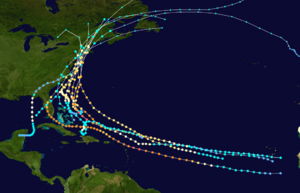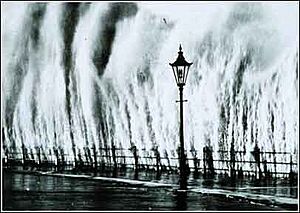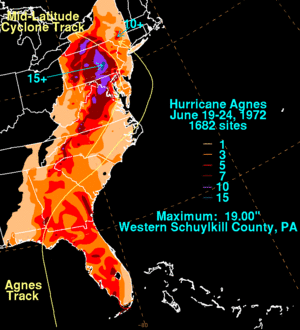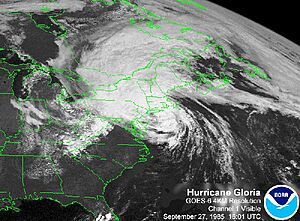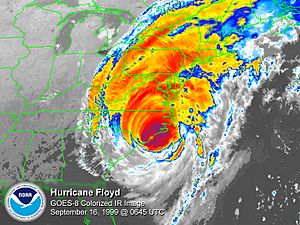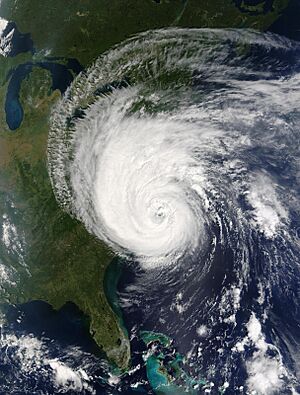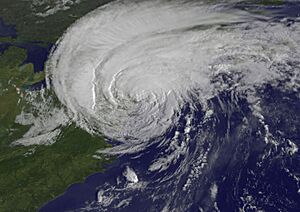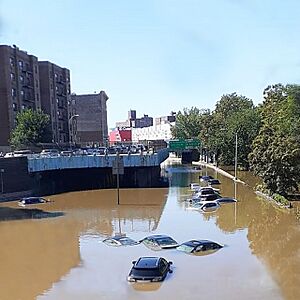List of New York hurricanes facts for kids
Eighty-seven big storms, like tropical cyclones and hurricanes, have hit or affected New York since the 1600s. New York is on the East Coast of the United States, in the Northeast part of the country. The strongest storm was the 1938 New England hurricane. It hit Long Island as a very powerful Category 3 hurricane. This storm also caused the most deaths, with over 60 people losing their lives.
Most of these storms have affected New York in September. However, they can happen during any month of hurricane season, which is from June to November. It's rare for a hurricane to hit New York directly. But it's common for parts of these storms to bring heavy rain and flooding.
Contents
Early Storms (1600s – 1700s)
- October 29, 1693: A huge storm, called the Great Storm of 1693, caused a lot of damage on Long Island. It's believed this storm created the Fire Island Cut with its strong waves and storm surge.
- September 23, 1785: Powerful waves from a tropical storm caused several large ships to crash into Governors Island.
- August 19, 1788: A hurricane hit New York City or Long Island. It caused severe flooding and left the west side of the Battery "in ruins."
Storms in the 1800s

This map shows the path of the 1821 Norfolk and Long Island hurricane.
- October 9, 1804: A hurricane moving north along the East Coast brought heavy snow to Eastern New York. Some places got up to 30 inches (75 cm) of snow!
- September 5, 1815: A hurricane tracked near the coast. It caused a heavy rainstorm in New York.
- September 24, 1815: Another hurricane hit Long Island. It knocked down hundreds of trees and stripped most of the fruit from apple trees.
- September 3, 1821: The 1821 Norfolk and Long Island hurricane caused major damage on Long Island. The storm surge was 13 feet (4 meters) high. High winds caused a ship to crash, and 17 people died.
- October 4, 1841: Strong winds affected New York City as a hurricane moved north. The damage was estimated at $2 million (which would be about $41 million today).
- October 13, 1846: The Great Havana Hurricane of 1846 moved inland and caused some damage to New York City.
- July 19, 1850: A hurricane destroyed a bath house in Coney Island and brought heavy rain. This storm also sank the ship Elizabeth off Fire Island.
- September 6, 1869: A very strong Category 3 hurricane brushed Long Island. It brought rain but caused only minor damage.
- August 24, 1893: Hog Island was washed away by the strong storm surge from a tropical storm. This storm was a Category 1 hurricane when it hit the Rockaway Peninsula. Manhattan Island saw strong winds up to 56 mph.
- August 29, 1893: The 1893 Sea Islands hurricane moved through the Hudson Valley as a tropical storm. People lost their lives in the Rockaways. Many roofs, buildings, boats, and crops were damaged or destroyed.
- October 10, 1894: Ten people died in Manhattan when strong winds blew a building under construction onto another building. There was a lot of damage to power lines, trees, and boats in New York City and Long Island.
Storms from 1900 to 1949
- September 12, 1900: Parts of the 1900 Galveston hurricane brought tropical storm conditions to New York City and Brooklyn. One person died, and property was damaged.
- September 17, 1903: The 1903 Vagabond Hurricane caused wind gusts over 65 mph (105 km/h) and 3 inches (75 mm) of rain in Central Park.
- August 25, 1933: The 1933 Chesapeake–Potomac hurricane brought up to 6 inches (150 mm) of rain to Southeast New York.
- September 21, 1938: The New England hurricane of 1938, also called "The Long Island Express," hit Suffolk County (Long Island). It was a Category 3 hurricane. Wind gusts reached 125 mph (201 km/h). The storm surge was 18 feet (5 meters) high. In New York, 60 people died, and hundreds were injured. About 2,600 boats and 8,900 houses were destroyed.
- September 14, 1944: The 1944 Great Atlantic hurricane hit Long Island as a Category 1 hurricane. Wind gusts over 100 mph (161 km/h) broke old records in New York City. About 117 homes were completely destroyed. Six people died, and one person was injured.
Storms from 1950 to 1974
- August 31, 1954: Hurricane Carol hit Long Island. It caused wind gusts of 120 mph (193 km/h) at Montauk Point. The storm surge covered the Montauk Highway, cutting off eastern Long Island for a while.
- October 15, 1954: Hurricane Hazel brought a wind gust of 113 mph (182 km/h) to Battery Park. This was the highest ever recorded in New York City.
- August 13, 1955: Hurricane Connie brought 13.24 inches (370 mm) of rain to Southeast New York.
- September 11, 1960: Hurricane Donna hit Long Island as a Category 2 hurricane. Winds reached 100 mph (161 km/h) on eastern Long Island. Tides were 6 feet (2 meters) higher than normal. Strong waves caused beach erosion and destroyed some homes. Thanks to good warnings, no deaths were reported.
- September 21, 1961: Hurricane Esther caused $3 million in damage in Suffolk County. This was about $20 million in 2007 money. Coastal areas of Long Island flooded. Wind gusts of 108 mph (174 km/h) left 260,000 homes without power.
- August 28, 1971: Tropical Storm Doria brought up to 8 inches (200 mm) of rain to New York City and Upstate New York. This caused moderate to severe flooding, including in New York City subways.
- June 22, 1972: Hurricane Agnes hit near New York City. It brought up to 12 inches (300 mm) of rain to Southeastern and Western New York. Storm tides were 3.1 feet (1 meter) high. Severe river flooding caused 24 deaths.
Storms from 1975 to 1999
- August 11, 1976: Hurricane Belle hit Long Island as a Category 1 hurricane. It brought up to 6 inches (150 mm) of rain. About 30,000 people in New York were moved to safety before the storm. Wind gusts reached 70 mph (113 km/h). One person died from a falling tree.
- September 27, 1985: Hurricane Gloria hit Long Island as a Category 2 hurricane. Wind gusts reached 100 mph (161 km/h). The storm caused $300 million in damage (about $591 million in 2007 money). One person died. Also, 48 homes on Long Island were destroyed.
- August 19, 1991: Hurricane Bob came very close to hitting the eastern tip of Long Island as a Category 2 hurricane. Heavy rain (up to 7 inches or 175 mm) and strong winds caused two deaths. It also caused $75 million in damage (about $117 million in 2007 money). The storm surge, up to 6 feet (2 meters) above normal, caused severe beach erosion.
- October 30, 1991: The 1991 Perfect Storm caused one man to die when he was swept off a bridge. It also caused moderate to severe beach erosion.
- August 18, 1994: Parts of Tropical Storm Beryl brought up to 3 inches (75 mm) of rain to Central New York. This caused moderate flooding. Two people died, and 14 homes were damaged or destroyed.
- July 13, 1996: Hurricane Bertha hit Long Island as a tropical storm. It brought heavy rain and strong winds.
- September 16, 1999: Hurricane Floyd brought up to 13 inches (325 mm) of rain and wind gusts up to 60 mph (97 km/h) to Southeastern New York. Severe flooding resulted in two deaths. One person died after being swept into a flooded river.
Storms from 2000 to 2009
- June 17, 2001: Parts of Tropical Storm Allison brought moderate rain (up to 3 inches or 75 mm) in just a few hours. This caused minor to moderate flash flooding.
- August 10, 2002: Tropical Storm Cristobal created dangerous rip currents. Three people drowned on the coast of Long Island.
- September 21, 2003: Hurricane Isabel brought high winds and flooding to New York. Damage in New York totaled $90 million (about $98 million in 2006 money). Around New York City, about 1.1 million homes lost power.
- September 9, 2004: Parts of Hurricane Frances brought heavy rainfall (up to 7 inches or 175 mm). This caused a lot of flooding in central New York. One person died from drowning, and the flooding caused $6 million in damage.
- October 5, 2005: Parts of Tropical Storm Tammy contributed to a rainstorm that became the Northeast U.S. flooding of October 2005. Up to 13 inches (325 mm) of rain caused severe flooding throughout the Hudson Valley. No deaths were reported in New York, but there were millions of dollars in damage.
- September 2, 2006: Parts of Hurricane Ernesto brought light to moderate rain and wind gusts up to 60 mph (97 km/h). Many trees and power lines fell. Several thousand people lost power, mostly in the New York City area.
- June 5, 2007: Tropical Storm Barry brought 3.91 inches (99 mm) of rain to New York City. The heavy rain caused flooding in the Finger Lakes region of New York State. Roads and driveways were washed out.
- September 6, 2008: Hurricane Hanna hit Long Island as a tropical storm. Wind gusts reached 52 mph (84 km/h) at Shinnecock Inlet. Damage was minimal, mostly just downed trees.
Recent Storms (2010 – Present)
- August 27–28, 2011: Hurricane Irene hit Coney Island as a tropical storm with winds of 65 mph (105 km/h). The storm surge flooded areas under boardwalks in Coney Island and Long Beach. The Hudson River also flooded. The storm killed five people in the state and had a big impact on Upstate New York.
- October 28–29, 2012: Hurricane Sandy, a historic storm, hit near Atlantic City, New Jersey. It had 80 mph (129 km/h) winds. This storm was unusual because it was a late-season hurricane that combined with another storm called a Nor'easter. It hit during high tide and a full moon. This caused long-lasting and terrible damage. Wind gusts reached over 100 mph (161 km/h) in some parts of the New York metropolitan area. Sandy caused a record 14.41 feet (4.39 meters) storm surge at Battery Park in New York City. This flooded parts of Lower Manhattan, including tunnels and subway systems. Over nine million customers lost power. Many low-lying neighborhoods were completely destroyed.
- June 7–8, 2013: Parts of Tropical Storm Andrea brought over 4 inches (100 mm) of rain and wind gusts of 45 mph (72 km/h) to New York.
- July 4, 2014: Hurricane Arthur passed southeast of New York. It brought light to moderate rain along the coast. Some holiday celebrations in the New York City area were canceled.
- September 19–20, 2017: Tropical Storm Jose passed close to Long Island. It brought heavy wind and rain.
- September 6–7, 2019: Hurricane Dorian caused warnings for dangerous rip currents. City beaches were closed to swimming and surfing because of the unsafe conditions.
- July 10–11, 2020: Tropical Storm Fay hit New Jersey and then moved into New York. In Long Beach, New York, a 19-year-old drowned after being caught in rip currents. The storm flooded several New York City Subway stations.
- August 4, 2020: Tropical Storm Isaias brought 3 to 6 inches (76.2 – 152.4 mm) of rain. Wind gusts reached 50 to 80 mph (80 to 130 km/h). Many trees fell, damaging homes. About 2.5 million people lost power.
- July 9, 2021: Hurricane Elsa brought heavy rain and flooding across the Northeast. Several subway stations and roads in Manhattan and the Bronx flooded.
- August 18, 2021: Parts of Tropical Storm Fred caused flooding across New York. Auburn, New York recorded 7.64 inches (19.4 cm) of rain.
- August 22, 2021: Hurricane Henri passed just east of Montauk Point as a tropical storm. It hit Long Island and New York City with heavy rain. Hurricane Henri's two-day rainfall in New York City was the most since Hurricane Irene.
- September 1, 2021: Parts of Hurricane Ida reached the New York City area. It brought very heavy rain and flooding. For the first time ever, New York City was put under a Flash Flood Emergency. It's estimated that 16 people died in the state, with 13 of those in New York City. Many died because their apartment basements flooded. New York City had its wettest hour in history, with 3.15 inches (8 cm) of rain falling in one hour.
- September 28–30, 2023: Tropical Storm Ophelia caused heavy rainfall. This led to flooding across the New York City area.
Storms by Month
| Month | Number of storms |
|---|---|
| June |
4
|
| July |
7
|
| August |
23
|
| September |
40
|
| October |
14
|
Storms That Caused Deaths
This table lists storms that caused deaths in New York State.
| Name | Year | Number of deaths |
|---|---|---|
| New England | 1938 | 60 |
| Sandy | 2012 | 53 |
| Agnes | 1972 | 24 |
| Norfolk | 1821 | 17 |
| Ida | 2021 | 17 |
| Connie | 1955 | 14 |
| Five | 1894 | 10 |
| Edna | 1954 | ≤8 |
| Great Atlantic | 1944 | 6 |
| Irene | 2011 | 5 |
| Gabrielle | 1989 | 4 |
| Cristobal | 2002 | 3 |
| Beryl | 1994 | 2 |
| Bob | 1991 | 2 |
| Floyd | 1999 | 2 |
| Lee | 2011 | 2 |
| Isabel | 2003 | 1 |
| Belle | 1976 | 1 |
| Gloria | 1985 | 1 |
| Frances | 2004 | 1 |
| Tammy | 2005 | 1 |
| Fay | 2020 | 1 |
| Isaias | 2020 | 1 |
| Carol | 1954 | 1 |
| Galveston | 1900 | 1 |
| Diane | 1955 | 1 |
See also
- List of New Jersey hurricanes
- List of New England hurricanes
- List of Pennsylvania hurricanes
- List of North Carolina hurricanes
- List of Florida hurricanes
- New York Harbor Storm-Surge Barrier

All content from Kiddle encyclopedia articles (including the article images and facts) can be freely used under Attribution-ShareAlike license, unless stated otherwise. Cite this article:
List of New York hurricanes Facts for Kids. Kiddle Encyclopedia.

